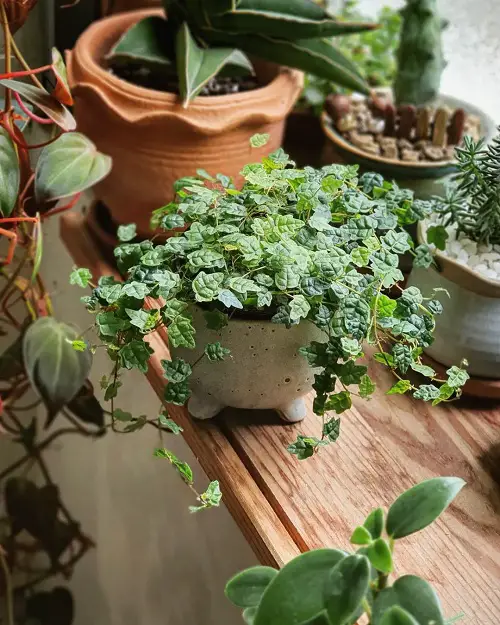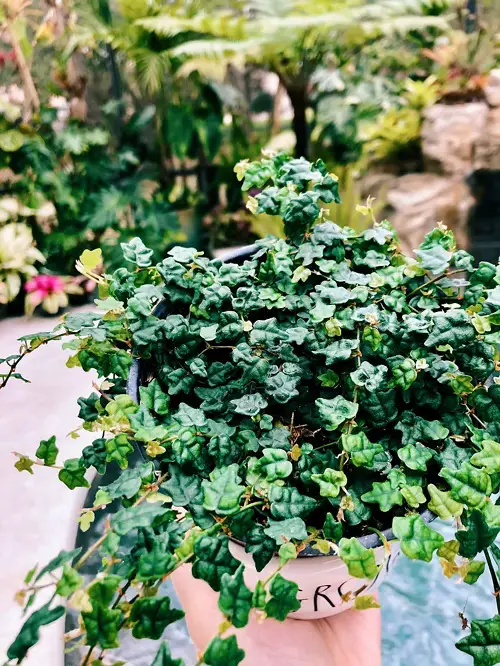Ficus pumila quercifolia Care is easy if you know the right steps. Here are all the details on How to Grow String of Frogs Plant !

A cultivar of the Creeping Fig, the Ficus pumila quercifolia plant is a low-maintenance creeping vine that looks beautiful on hanging baskets and countertops. Read on to get detailed information!
Check out the best string of pearls here
Ficus pumila quercifolia Plant Profile
Member of the Moraceae family, Ficus pumila quercifolia is an invasive grower native to East Asia and the tropics. Its leaves are small and lobed like those of an Oak tree, making them look like tiny frogs – which is where their name comes from.
It is a lovely choice growing no more than 1-2 inches in height. But it can spread 8-12 inches, making it perfect for small pots. Its woody vines can spread vigorously, but you can train this easy-to-grow specimen around the house for a lush tropical display.
Check out the most beautiful types of strings of hearts here
Ficus pumila quercifolia Propagation
Don’t go for Ficus pumila quercifolia seeds. The easiest method to multiply this plant is via cuttings. Cut a 5-6 inches stem below the leaf node using a sharp, sanitized shear. Remove all the leaves, leaving the upper pair intact. Fill a 6-8 inches pot with light, well-draining potting mix and plant the cutting.
Place the pot at a well-lit location with bright indirect sunlight and water it well. You’ll notice new growth in 30-40 days.
Here are the best string of heart alternatives
Requirements for Growing Ficus pumila quercifolia

Sunlight
Ficus pumila var. quercifolia does best in 4-6 hours of dappled sunlight. Exposure to the direct afternoon sun will scorch its leaves, leading to crisp brown tips and faded foliage – remember that. But a bit of morning sun exposure every day will keep it lush and bushy.
Soil
The String of Frogs thrives in a well-draining potting mix with a neutral pH of 6.5-7. Grow the creeper in a mixture of 40% garden soil, 40% coarse sand, and 20% aged manure.
You should make sure to amend the medium with a handful of perlite or vermiculite to boost drainage. Adding organic matter will also boost its growth.
Water
Water the plant when you feel the top soil is dry to the touch. It is better to follow a weekly deep watering session to keep the medium moist throughout. You should not overwater it if you want to keep potential diseases at bay.
Temperature & Humidity
Ficus pumila quercifolia appreciates a relatively warm climate to grow well. The optimal temperature ranges from 55-75 F or 13-24 C. Anything below 50 F or 10 C will cease its growth, and above 75 F or 24 C will shrivel and fade its leaves. Keep the following in mind:
- The plant is highly non-resistant to frost; ensure to keep it away from cold drafts and bring the plant indoors in winter.
- The String of Frogs needs 60-80% humidity to thrive beautifully. Use a humidifier or pebble tray for drier days.
Learn how to make a string of pearls bushier here
Ficus pumila quercifolia Care

Fertilizer
Ficus pumila quercifolia doesn’t require fertilization if grown in a nutrient-rich potting mix. However, you may feed it with a balanced liquid fertilizer, diluted to one-fourth of its strength, every 4-6 weeks when it is actively growing. Avoid fertilizing it in colder months.
Pests & Diseases
This Ficus cultivar is easily susceptible to various pests, including spider mites, mealybugs, and scales. Spray insecticidal soap to keep these pesky pests at bay. You may swab the infected areas with a cotton pad dabbed in diluted rubbing alcohol.
Avoid over-watering and place the plant in an airy location to avoid fungal issues.
Pruning
Prune the stems from time to time to keep their spread in check. Also, make sure to remove any dead or damaged foliage when you spot it.


